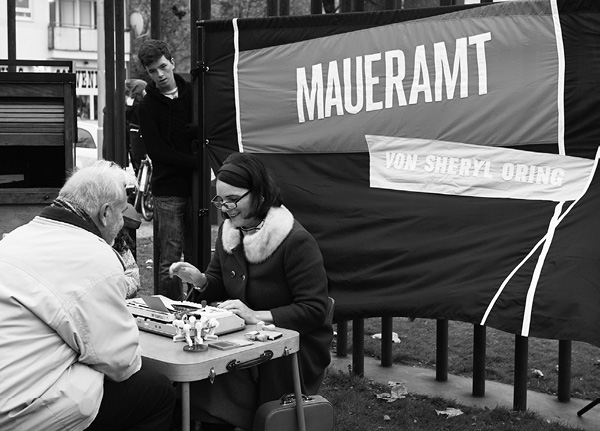
MAUERAMT
first performed on September 4, 2014
Berlin Wall Memorial, Berlin, Germany
performed twelve times in 2014
SHERYL ORING
Greensboro, NC / Berlin, Germany
814749176o814749176r814749176i814749176n814749176g814749176@814749176i814749176w814749176i814749176s814749176h814749176t814749176o814749176s814749176a814749176y814749176.814749176o814749176r814749176g814749176 814749176/814749176 814749176s814749176a814749176o814749176r814749176i814749176n814749176g814749176@814749176u814749176n814749176c814749176g814749176.814749176e814749176d814749176u
sheryloring.org
MAUERAMT
SHERYL ORING
November 9, 2014, was the 25th anniversary of the fall of the Berlin Wall. As I’ve engaged various aspects of German history with past projects, this anniversary compelled me to create a work that examined how this critical moment in history is viewed today by both Germans and non-Germans. With “Maueramt” or “Wall Department,” I set up a public office along what remains of the Wall that separated East and West Berlin and asked passersby: “What do you think about when you think about the Berlin Wall?” I was dressed in 1960s era office attire; my office desk was an East German camping table that folded neatly for easy transport by an old three-wheeled bike with wooden compartments. Answers were typed on a West German “Princess” typewriter and these documents plus Polaroid photos of each participant were then integrated into an installation at the Museum THE KENNEDYS in Berlin.
The work engaged both young and old and served to provoke reflection on changes over the past several decades that have radically rebuilt the city. Said one Berliner: “I’ve lived in Berlin since 1958. In the West. Without family. Mother and brother remained in the East. It wasn’t easy. Little to eat. Studies and work with no family.” For young people who have grown up without this division, the project served as a provocation and often led to long conversations about the Wall and its impact on people and families. Said one German child: “When I think about the Wall, I think about the DDR and of death and war. And of escape and separation—that many people didn’t see their families for a long time.” For my own daughter, age six, watching the performances led to discussions on protest and democracy and I’m certain that these lessons—enhanced by seeing remnants of the Wall—will remain vivid in her mind for years to come. Her message read in part: “Some people might ask how did they force the government to take it down—they went on the road and lots of people did it and the government went with it because they couldn’t stand to hear all the shouting and see all the signs.”